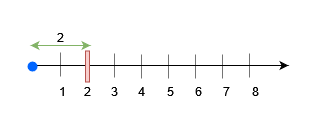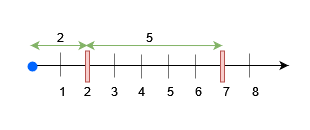Description
There exists an infinite number line, with its origin at 0 and extending towards the positive x-axis.
You are given a 2D array queries, which contains two types of queries:
- For a query of type 1,
queries[i] = [1, x]. Build an obstacle at distancexfrom the origin. It is guaranteed that there is no obstacle at distancexwhen the query is asked. - For a query of type 2,
queries[i] = [2, x, sz]. Check if it is possible to place a block of sizeszanywhere in the range[0, x]on the line, such that the block entirely lies in the range[0, x]. A block cannot be placed if it intersects with any obstacle, but it may touch it. Note that you do not actually place the block. Queries are separate.
Return a boolean array results, where results[i] is true if you can place the block specified in the ith query of type 2, and false otherwise.
Example 1:
Input: queries = [[1,2],[2,3,3],[2,3,1],[2,2,2]]
Output: [false,true,true]
Explanation:

For query 0, place an obstacle at x = 2. A block of size at most 2 can be placed before x = 3.
Example 2:
Input: queries = [[1,7],[2,7,6],[1,2],[2,7,5],[2,7,6]]
Output: [true,true,false]
Explanation:

- Place an obstacle at
x = 7for query 0. A block of size at most 7 can be placed beforex = 7. - Place an obstacle at
x = 2for query 2. Now, a block of size at most 5 can be placed beforex = 7, and a block of size at most 2 beforex = 2.
Constraints:
1 <= queries.length <= 15 * 1042 <= queries[i].length <= 31 <= queries[i][0] <= 21 <= x, sz <= min(5 * 104, 3 * queries.length)- The input is generated such that for queries of type 1, no obstacle exists at distance
xwhen the query is asked. - The input is generated such that there is at least one query of type 2.
Solution
C++
class Solution {
public:
int N = 50005;
int MAX = 4 * 50005 + 5;
int arr[50005];
int tree[4 * 50005 + 5];
int lazy[4 * 50005 + 5];
int INF = 1e9;
void build(int a[], int v, int tl, int tr) {
if (tl == tr) {
tree[v] = a[tl];
} else {
int tm = (tl + tr) / 2;
build(a, v*2, tl, tm);
build(a, v*2+1, tm+1, tr);
tree[v] = max(tree[v*2], tree[v*2 + 1]);
}
}
void push(int v) {
tree[v*2] += lazy[v];
lazy[v*2] += lazy[v];
tree[v*2+1] += lazy[v];
lazy[v*2+1] += lazy[v];
lazy[v] = 0;
}
void update(int v, int tl, int tr, int l, int r, int addend) {
if (l > r)
return;
if (l == tl && tr == r) {
tree[v] += addend;
lazy[v] += addend;
} else {
push(v);
int tm = (tl + tr) / 2;
update(v*2, tl, tm, l, min(r, tm), addend);
update(v*2+1, tm+1, tr, max(l, tm+1), r, addend);
tree[v] = max(tree[v*2], tree[v*2+1]);
}
}
int query(int v, int tl, int tr, int l, int r) {
if (l > r)
return -INF;
if (l == tl && tr == r)
return tree[v];
push(v);
int tm = (tl + tr) / 2;
return max(query(v*2, tl, tm, l, min(r, tm)),
query(v*2+1, tm+1, tr, max(l, tm+1), r));
}
vector<bool> getResults(vector<vector<int>>& queries) {
for(int i=0; i<N; i++) arr[i] = i;
vector<bool> ans;
build(arr, 1, 0, N - 1);
memset(lazy, 0, sizeof lazy);
set<int> st;
st.insert(N - 1);
for (auto &it: queries) {
if (it[0] == 1) {
int x = it[1];
int val = query(1, 0, N - 1, x, x);
int right = *st.lower_bound(x);
update(1, 0, N - 1, x + 1, right, -1 * val);
st.insert(x);
} else {
int x = it[1], sz = it[2];
int val = query(1, 0, N - 1, 0, x);
ans.push_back(val >= sz);
}
}
return ans;
}
};